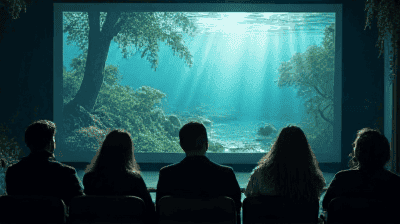
Storytelling has always been an essential part of human culture. It is a way to convey ideas, share experiences, and connect with others. In recent years, the power of storytelling has been harnessed to inspire environmental action through films and books. As climate change, biodiversity loss, and pollution threaten our planet, creative narratives can play a crucial role in raising awareness, educating audiences, and motivating individuals to take action to protect the environment.
One of the primary strengths of storytelling is its ability to engage people emotionally. When individuals connect with a character or a narrative, they become more invested in the story's outcome. Environmental issues can often feel abstract or overwhelming, but relatable characters and compelling narratives can make these challenges more tangible and accessible.
Stories can foster empathy by allowing readers and viewers to see the world through someone else's eyes. Environmental narratives often highlight the struggles of people affected by climate change, pollution, and habitat destruction. By humanizing these issues, storytelling encourages audiences to care about the environment on a personal level.
Environmental challenges are often complex, involving intricate scientific concepts and data. Effective storytelling can simplify these topics, making them easier for audiences to understand. By framing scientific facts within a narrative, storytellers can enhance comprehension and retention.
Engaging narratives can inspire audiences to take action. Whether it is through advocacy, lifestyle changes, or community involvement, stories that illustrate the impact of individual actions can empower people to make a difference. The sense of urgency conveyed in impactful narratives can motivate audiences to act now, rather than later.

Documentaries are a powerful medium for conveying factual information about environmental issues. They often include expert interviews, on-the-ground reporting, and compelling visuals that illustrate environmental challenges. Here are some notable documentaries that have inspired environmental action:
"An Inconvenient Truth": This groundbreaking documentary featuring former Vice President Al Gore educated millions about climate change. The film combines compelling visuals with personal stories, making the science of climate change accessible and urgent.
"Our Planet": Narrated by Sir David Attenborough, this series showcases the beauty of the natural world while highlighting the threats posed by climate change and habitat destruction. The stunning cinematography captivates audiences, while the message calls for immediate conservation efforts.
"Chasing Ice": This documentary follows photographer James Balog as he documents the melting of glaciers in the Arctic. The powerful imagery and emotional narratives emphasize the urgency of climate change and the need for action.
Feature films can also address environmental themes and inspire action through their storytelling. They often blend entertainment with education, making complex issues accessible to a broader audience. Some notable examples include:
"Wall-E": This animated film from Pixar presents a dystopian future where Earth is covered in waste. It highlights themes of consumerism, pollution, and environmental neglect while featuring a hopeful message about redemption and change.
"FernGully: The Last Rainforest": An animated film that tells the story of a young fairy who fights to save her rainforest home from destruction. The film raises awareness about deforestation while promoting environmental stewardship among young audiences.
"The Lorax": Based on Dr. Seuss's classic book, this animated adaptation emphasizes the importance of taking care of the environment and the consequences of greed and industrialization.
Short films and online series are increasingly popular formats for environmental storytelling. They are often more accessible and can be easily shared on social media, allowing for rapid dissemination of important messages.
"The Ocean Cleanup": This short documentary follows the organization working to rid the oceans of plastic pollution. It showcases the challenges and triumphs of innovative solutions to a critical environmental problem.
"The Climate Reality Project": Founded by Al Gore, this initiative produces a variety of short videos and social media content aimed at raising awareness about climate change and inspiring individuals to take action.
Non-fiction books can educate readers about environmental issues, provide insights into scientific research, and inspire action through personal narratives. Some influential non-fiction titles include:
"Silent Spring" by Rachel Carson: This groundbreaking book raised awareness about the dangers of pesticides and their impact on the environment. Carson's eloquent prose and meticulous research ignited the modern environmental movement in the 1960s.
"This Changes Everything" by Naomi Klein: This book examines the relationship between capitalism and climate change, arguing for systemic change to address the climate crisis. Klein's compelling arguments challenge readers to reconsider their roles in the consumer economy.
"The Hidden Life of Trees" by Peter Wohlleben: This book delves into the complex social networks of trees and forests, illustrating the interconnections of ecosystems. Wohlleben’s passion for nature and thoughtful storytelling promote a deeper understanding of conservation.
Fictional narratives can also convey environmental themes, engage readers’ imaginations, and promote environmental awareness. Some notable works of fiction include:
"The Overstory" by Richard Powers: This Pulitzer Prize-winning novel interweaves the stories of multiple characters whose lives are interconnected with trees. The book highlights the relationships between humans and nature, urging readers to reconsider their connections to the environment.
"Flight Behavior" by Barbara Kingsolver: This novel addresses climate change and its unintended consequences through the story of a small Appalachian community facing environmental crisis. Kingsolver's evocative storytelling encourages readers to connect with ecological themes.
"Parable of the Sower" by Octavia Butler: Set in a dystopian future ravaged by climate change and social collapse, this novel explores themes of survival, resilience, and community. Butler’s work raises important questions about the future of humanity in a changing world.

Hosting community screenings of impactful films can create opportunities for discussion and action. Following the film, organize a panel discussion or a community forum where participants can share their thoughts and brainstorm actionable steps.
Establishing book clubs focused on environmental literature allows for in-depth discussions and personal connections to the material. These clubs can include local environmental leaders as guest speakers to discuss practical applications of the concepts presented in the books.
Educators can incorporate films and books into their curricula to address environmental topics actively. Through immersive storytelling, students can better understand complex issues, leading to projects and initiatives that promote environmental stewardship.
Leverage social media platforms to share powerful narratives, quotes, and visuals from environmental films and books. Encouraging audiences to share their favorite environmental stories can amplify awareness and inspire action.
Partnering with authors and filmmakers for events can enhance audience engagement. Invitations to speak about their work can deepen understanding of the themes and encourage participants to take action based on what they have learned.
Collect qualitative and quantitative data from audiences to assess the impact of storytelling on environmental attitudes and behaviors. Surveys can gauge participants' knowledge before and after initiatives, helping to measure shifts in understanding and commitment to action.
Encourage participants to report any actions taken in response to the storytelling initiatives. This could include individual lifestyle changes, participation in community projects, or advocacy efforts.
Conducting longstanding studies that follow participants over time can help assess the lasting impact of storytelling on environmental behavior and engagement.

The power of storytelling through films and books is undeniable. As we face unprecedented environmental challenges, narrative is a crucial tool for raising awareness, educating the public, and inspiring action. Films and books connect us to the environment, foster empathy, simplify complex issues, and motivate us to act.
By harnessing the power of storytelling, we can build a global movement for change that transcends barriers and empowers individuals to take collective action. As audience members and readers engage with compelling narratives, they can become active participants in a more sustainable future. Whether through documentaries that highlight urgent issues, novels that explore the human-nature connection, or community conversations sparked by shared stories, the potential for storytelling to inspire environmental action is vast and vital.
Let us embrace this power and utilize it to create a world that values and protects the planet for generations to come.